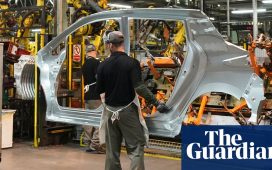When the Port Authority of New York and New Jersey embarked on $19 billion transformation of Kennedy Airport in 2022, part of its promise was a more modern, convenient and safe experience for travelers.
At an unassuming office park in Bohemia, engineers and technicians are testing a variety of technologies they say will be the “brains” behind the transformed airport that will include two new terminals, updates to others and a simplified road network. Some additions — including a new Terminal 1 for international flights — are expected to open in June 2026, while others will take until 2030.
At the JFK Terminal 1 Pre-Production Center, contractors are tinkering with automated check-in and boarding kiosks that use facial recognition, potentially allowing travelers to glide through checkpoints without presenting identification. They are also testing self-service baggage drop stations and dozens of other technologies that travelers don’t typically see, like lighting and laser systems to guide pilots from the runway to the gate.
“The technology that’s being tested out at this site, from check-in to baggage handling and everything that comes as part of the airport experience, will be state of the art,” said Hersh Parekh, deputy chief of intergovernmental affairs for the Port Authority during a tour for reporters Thursday.
The testing is beginning about two years ahead of rollout to ensure the new technologies work together, said Ricardo Pinillos, a project executive with Spain-based Ferrovial Construction, a partner on the project.
The $19 billion construction project at Kennedy Airport — of which the new technology is just one part — is funded through a partnership between the Port Authority and New Terminal One, a private consortium of companies led by Ferrovial.
New Terminal One has invested $15 billion, while the Port Authority is covering the rest — mostly with its own revenues rather than taxpayer dollars, according to Tom Topousis, a spokesperson.
Once the construction is complete, New Terminal One will operate and maintain the facility under a long-term lease from the Port Authority.
Facial recognition technology to be used
Travelers at the new terminal may be able to get from the curb to their gate without showing an identification to a human, according to John Myslinski, a project manager with SITA, a Switzerland-based company coordinating the various technological components. Once travelers scan their identification and face at a check-in kiosk, they can automatically pass through subsequent checkpoints.
“Your face is your ID and your face is your boarding pass. So at any particular point along the journey, you look at a camera and you process through,” Myslinski said.
He said the technology has been found to be about 99% accurate at identifying faces — more accurate than humans.
In recent years, law enforcement use of facial recognition technology has received criticism from civil rights groups after performing poorly on Black people and other people of color, in some cases leading to wrongful arrests of people for crimes they did not commit.
But Myslinski said the airport scanners have proved accurate on people from different racial backgrounds.
Airlines will have to subscribe for passengers to use the system, and travelers’ biometric data will be stored only for 24 hours, Myslinski said. Individuals will be allowed opt out of the automated systems, according to the Port Authority.
SITA has implemented a similar biometric system at the airport in Frankfurt, Germany.
Impacts on the environment, jobs
Another technology being tested at the Bohemia facility is a digital system for managing and assigning a place in line to aircraft on the “apron” — the space between the terminal gates and the taxiway. Most American apron controllers still do this work using slips of paper, according to Taha Zahir, a project manager with ADB Safegate who is working on the project. But Kennedy will be one of the first U.S. airports to transition to a digital system, he said.
Other technologies being tested could reduce the time that aircraft idle before takeoff and after landing — such as a color-coded light system to guide pilots between the runway and the terminal, and another that utilizes lasers to help them park. These technologies could help reduce carbon emissions, according to the Port Authority.
The ongoing construction work is expected to create over 10,000 jobs, including 6,000 union construction jobs, according to the Port Authority.










